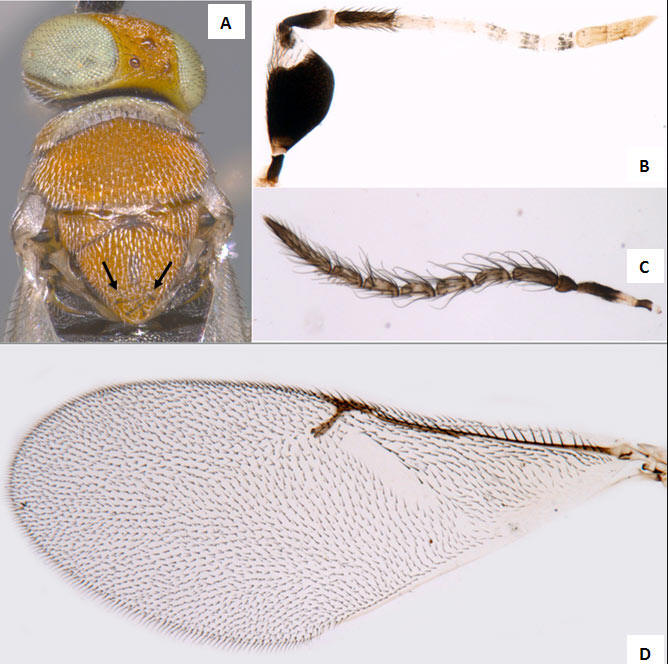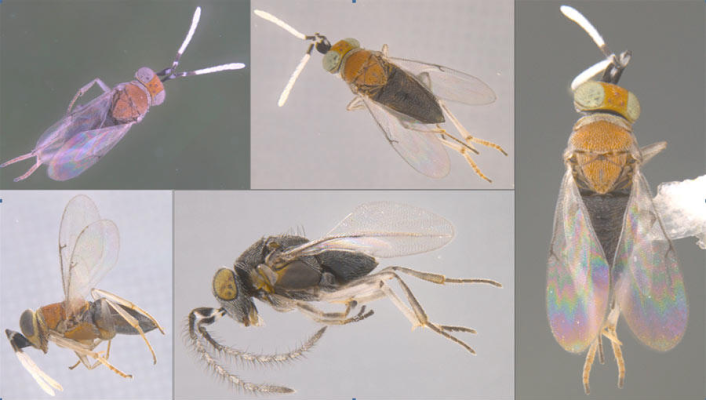 |
Scientific nameAnagyrus loecki Noyes & Menezes
Taxonomic positionHymenoptera: Chalcidoidea: Encyrtidae: Tetracneminae
DiagnosisFemale: Length: 1.45-1.75 mm long. Female (Fig. 2) with body robust, slightly flattened dorsoventrally. Head, mesoscutum and scutellum orange; frontovertex with conspicuous white setae and a few dark setae in ocellar area; eyes greenish with minute black setae; gaster dark brown, ovipositor not prominent. Antennal formula 1163 (Fig. 1B); scape broad, dark brown to black, externally with a white basal spot and a white subapical band in distal one-third; pedicel brown, distally white, F1 dark brown, rest of antenna white. Forewing (Fig. 1D) with costal cell broad, with two complete lines of setae ventrally, marginal and postmarginal veins combined a little longer than stigma; linea calva interrupted by three rows of setae.
Male: Much smaller than females (0.95-1.10 mm). General colour dark brown to black (Fig. 2), sides of pronotum, axillae and mesopleuron partly yellowish. Head and dorsal side of thorax covered in conspicuous silvery white setae, these most dense on lower parts of face. Antenna (Fig. 1C) with flagellar segments covered with whorls of setae; scape basally white with a broad, median blackish marking; F1 brownish, darker than other flagellar segments, extreme apex of club darker than remainder; F1 about 1.5x as long as F2; about 5 scale-like structures on F6 and base of club. Forewing similar to that of female, but setae less dense (from Noyes, 2000). Similar species: There are about 50 species of Anagyrus in India (Hayat, 2006), many of which externally look similar to A. loecki. It has a superficial resemblance to a large number of species in India and elsewhere, which are orange with antennae having only F1 dark brown with the rest of the flagellar segments white. The members of Anagyrus are commonly collected as parasitoids of mealybugs and hence care should be taken to identify them correctly. Noyes (2000) has provided a detailed description of both sexes of A. loecki with illustrations. Images Fig. 1. Anagyrus loecki: A. Female, head and thorax in dorsal view; B. Female antenna; C. Male antenna; D. Female forewing  Fig. 2. Anagyrus loecki - Dorsal and lateral view (all females except the fourth, clockwise from top left) DistributionCosta Rica; Mexico; St. Kitts; USA (Texas, Florida); Introduced in Sri Lanka. Introduced
and field releases made after quarantine screening in some parts of India.
Hosts / BiologyThis parasitoid described from Costa Rica and Mexico has a broad host range. The holotype was reared from Dysmicoccus nr. hurdi McKenzie and laboratory cultures were established on Phenacoccus madeirensis Green. Specimens of a hyperparasitoid, Chartocerus sp. (Chalcidoidea: Signiphoridae) were collected from the mummy from which the holotype was reared (Noyes, 2000).
References
|
